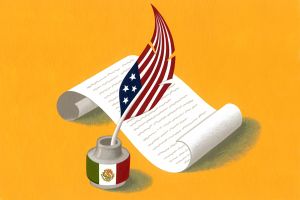UCSB professor Ellen McCracken pushed open the narrow little window onto academia that is the Chronicle of Higher Education–at least a little bit. Commemorating the recent death of Luis Leal, the don of Mexican/American literary history, McCracken argues, in her headline, “Latino Literature Should be an Essential Part of the Canon.” A casual reader might think this yet another manifesto for including more recent ‘hyphenated’ ethnic texts into the unmoving monolith that U.S. (“American”) literature is presumed to be. The Chronicle‘s well-meaning illustrator conveys that idea with this image of a Stars ‘n Stripes pluma being dipped into the inkwell of the Mexican flag, as if to write on a parchment document (is that the Declaration of Independencia, or Harry Potter’s homework?). I suppose this archaic imagery is one way to convey the idea we’re always trying to get at in our research and teaching here: writing by, and directed toward, people of Latin American descent in the U.S. didn’t just start appearing yesterday, or in the 1970s–but much farther back than that.
But no. McCracken is after her own department, Spanish & Portuguese at Santa Barbara, which is considering eliminating their requirement that PhD students take a course in US Latino literature. All graduate programs in Spanish, she argues, should have such a requirement, in part for the pragmatic reason that it will help their students get teaching jobs in which they will be called upon to respond to the growing numbers of Latinas/os (some 45 million of us, and counting) who are showing up in greater and greater numbers on the doorstep of the university.
Notes McCracken: “Some argue that contemporary U.S. Latino literature is primarily written in English and therefore should not be part of Spanish departments. Those who hold that view fail to understand its rich Spanish sources, its Mexican, Puerto Rican, Cuban, Dominican, Salvadoran, Colombian, and other Latin American roots. Moreover, as Frances Aparicio and others have argued, many of those texts engage in tropicalized English, which requires knowledge of Spanish to understand not only their bilingualism, but the Hispanic linguistic subtext.” Sin duda. But I think McCracken assumes too much about the place of Latino literature in English departments (or, at least, she couldn’t address this in the brief space she was given). She writes, “Just as African-American and women’s literature sought and were accorded inclusion within the literary canon and the college curriculum, so too did Latino literature.” Presumably the canons and curricula she’s speaking about here are Anglophone–but this is far from being a universal achievement. Are there Latino lit courses being taught regularly in the English Department at Yale? (Go ahead, look.) Or at my alma mater, Swarthmore? Tampoco. (Never mind that this tiny liberal arts college has produced two other now-tenured-professors in the field besides me: Laura Lomas and Antonio Viego.)
Part of what makes this field so interesting to work in is that its institutional locations are so variable. Nobody “owns” Latino Lit in the way that Spanish departments, say, own Cervantes. This, I believe, is a good thing, just like open-source code. The politics within, and among, these academic sub-disciplines mean that inserting a text or author into any given story about the development of a ‘tradition’ will inevitably distort them both. That image of the Mexican inkwell, for instance: doesn’t it imply that Mexicanness is just another ‘raw material’ that the great national pen can make use of to tell its story? Doesn’t that seem to fly in the face of McCracken’s argument here?
Or am I just suffering from 4th of July overload?
